The simple and repetitive nature of the 12 bar blues brings with it a range of benefits, in addition to a number of challenges.
The significant benefit of the 12 bar blues is that it is easy to learn, predictable, and (as the name suggests), widely used in the blues. This means that after learning just one chord progression, typically composed of just three chords, you are in a position where you can jam and play over a huge number of blues songs.
The challenge that comes with this, is that it can be difficult to make the chord progression interesting and varied. After all, if you just play the three chords and do nothing to add any life to the progression, it can quickly become stale and repetitive.
There are a number of ways to add life to a 12 bar blues, including using riffs, adding licks and playing chords that move beyond dominant 7ths.
In today’s quick win lesson however, I will be looking at how you can alter your chord voicings to create a different feel in your playing. So without further ado, let’s get into it!
An introduction to chord voicings
Before we look at different voicings of dominant 7th chords that you can use in your 12 bar blues progressions, I think it is first worth establishing what is meant by the term ‘chord voicing’.
In short, the position in which you play a chord on your guitar, which notes appear within the chord and in what order, and how those notes are spaced all determine the voicing of a chord.
I appreciate this sounds a little complicated. However it becomes much more obvious when we look at a musical example:
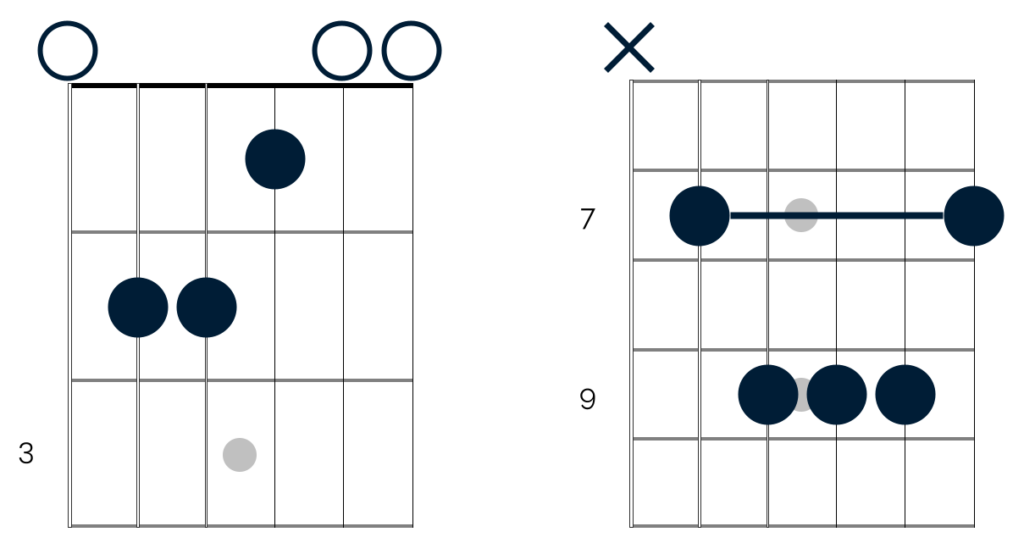
This diagram shows two different versions or ‘voicings’ of an E major chord.
Yet even though they are the same chord , when you play them one after another, you can hear that they sound quite different:
You can see why this is the case if we examine the differences between the two chords in more detail:
Most obviously, the chords are played in different registers of the guitar.
The E major from the diagram on the left is in the open position, and so uses notes from some of the lowest available pitches on the guitar. Conversely, the E major from the diagram on the right is played at the 7th fret, which makes the chord higher in pitch.
Beyond that, there is one further difference worth noting. In the E major chord that appears in the open position, you play all 6 strings.
There are only three notes in an E major chord, which run E G# B.
So when you play an E major chord in the open position, you play the following notes in this order:
E B E G# B E
Conversely, in the voicing played at the 7th fret, you play just 5 notes across 5 strings, in the following order:
E B E G# B
So in the first version of the chord, the note of E appears three times across three different octaves. In the second chord it appears twice over two octaves.
This might feel like a small change, but it alters the content of the chord and gives it a slightly different character and feel.
Although it goes beyond the scope of this lesson, there are a variety of further ways you can alter your chord voicings. This includes using inversions – where you start the chord on a note other than the root -as well as open chords – where you create wider spaces between the notes in the chords.
We will touch on inversions below. Broadly speaking though you don’t need to worry too much about these points at the moment. The key concept to appreciate is that there are different voicings for chords, and it is important to target these different chords intentionally.
There are three reasons for this, which are as follows:
Variety
As noted at the beginning of this lesson, mixing up your chord voicings will help you to play more varied and interesting rhythm parts. Always playing the same chord voicings is likely to get repetitive and boring – both for you and potentially also your audience.
Style
Certain voicings lend themselves to a particular style or feel. For example, it is unlikely that you would encounter a higher pitched and more delicate chord voicing in a song with a very heavy and intense feel.
For the same reason, in less melancholic musical contexts, musicians often favour chord voicings in higher registers on the guitar.
You can see this in genres like funk – whose rhythm parts are typically focused around higher pitched and more delicate chord voicings.
Positioning
Lastly and significantly, different chord voicings place you into different positions on the fretboard.
As you might expect, this has the potential to impact the sound of the chord itself. The knock on effect however, is that it also impacts your musical choices after you have played the chord.
We can see this when we compare the songs ‘Comfortably Numb‘ by Pink Floyd and ‘The Thrill Is Gone‘ by B.B. King.
Both of these songs are in the key of B minor and start on a B minor chord. However they utilise different voicings of this B minor:
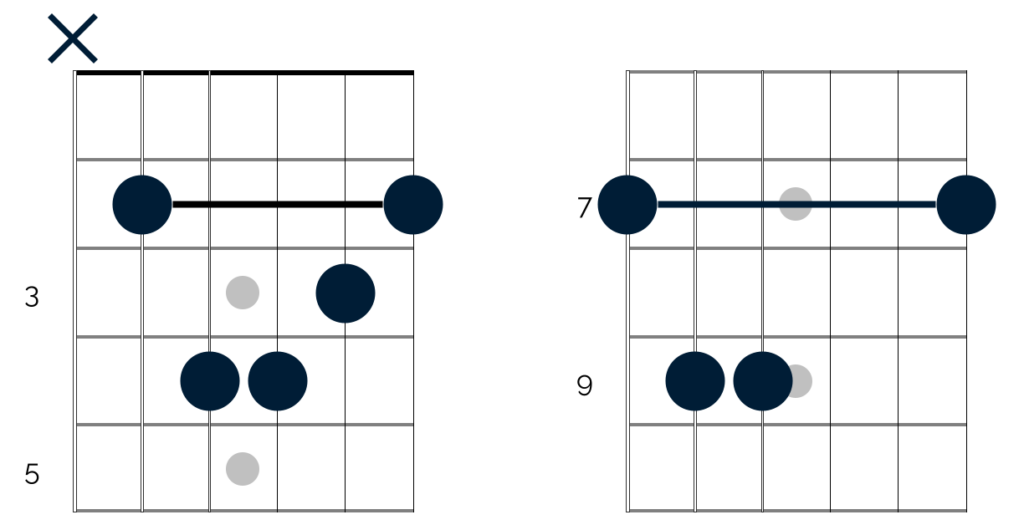
In Comfortably Numb, David Gilmour utilises the B minor chord illustrated in the diagram on the left, whilst B.B. King opts for that shown on the right. As you can hear in the following audio clip, there isn’t a great deal of difference between these two voicings:
The voicing on the diagram on the right (which is played in the second bar of audio) has a higher pitch and a slightly more delicate sound, however these differences are not pronounced.
What follows however, is more significant.
In both songs, the chord progression moves to the chord of E minor. Now, because of the positions in which the musicians are playing, the divergence in sound between the chords is greater:
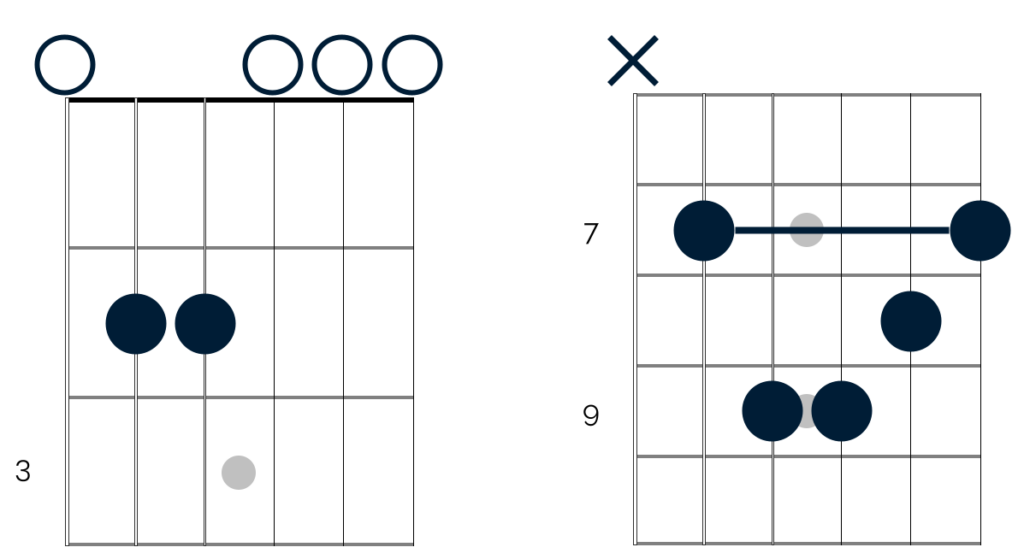
David Gilmour opts for the E minor chord illustrated in the diagram on the left, whilst B.B. King plays that shown on the right. As you can hear in the following audio, the character of these two chords is really quite different:
This is significant, as each chord serves the musical context of its respective song. In Comfortably Numb, the open position voicing adds to the dark and ominous feel of the verse section.
By comparison, opting for the higher pitched voicing gives The Thrill Is Gone a less melancholic and oppressive feel.
In summary then, the chord voicings that you choose have an impact on the other ideas you play – both with regards to chords, as well as single note lines and solos.
Dominant 7th voicings
At this point, we can look at how to apply this idea in the blues.
As in any genre, there is a wide variance of different progressions, riffs and song structures that you will encounter in the blues.
Having said that, the starting point for many of these different ideas – and the most common chord progression you will encounter in the blues – is a 12 bar progression made up of 3 different dominant chords.
If you are new to the structure of the 12 bar blues and how these chords are played within this structure, then I would head over to this article before continuing – An introduction to the 12 bar blues.
Assuming that you do know this structure, then hopefully you are in a position where you can play the 12 bar blues in a range of different keys. If that is the case, then you might well have a number of ‘go-to’ chord voicings that you use.
In the key of E for example, you might opt to play these 3 chords:
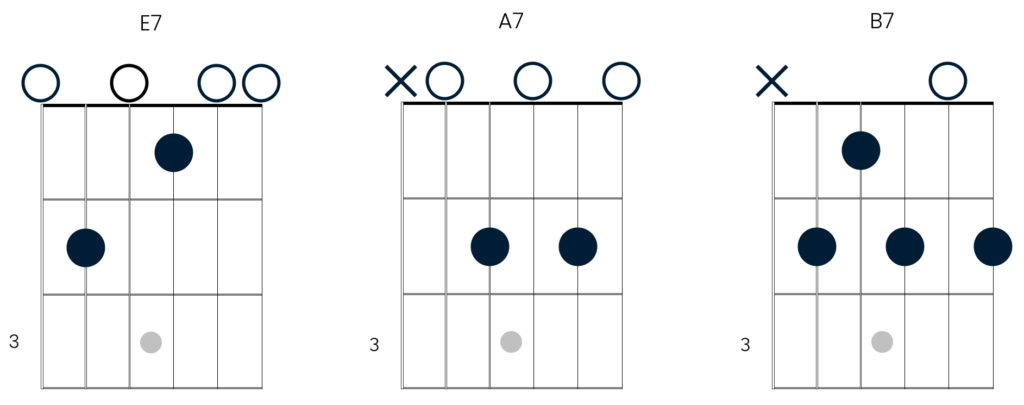
For every dominant 7th chord however, there are a variety of different voicings available.
To cover all of these goes beyond the scope of this article. However you can create much more varied and interesting blues progressions by learning the following dominant 7th chord voicings:
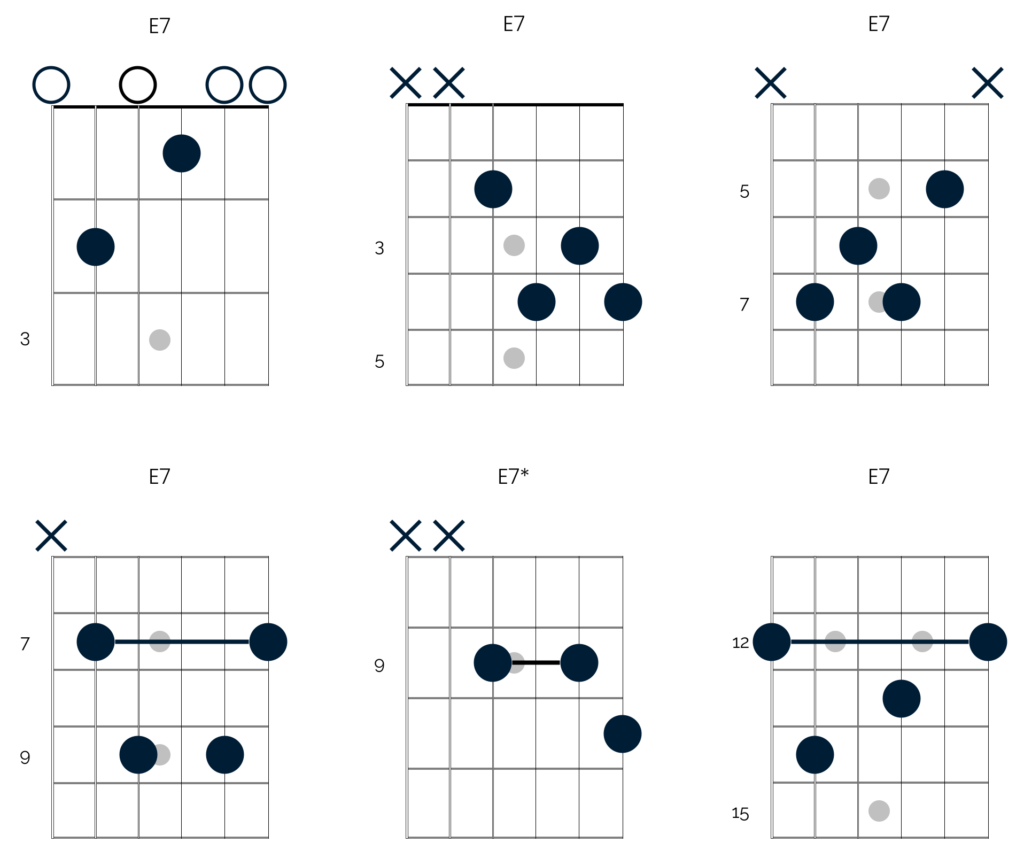
This diagram shows 5 different versions of an E7 chord, and one which is repeated twice – first in the open position and then again an octave higher.
All of these shapes are moveable. This means that you can apply them to all of the different chords that you might currently be using in your rhythm playing.
All you need to do is find the root note of the chord that you are trying to play on either the E, A or D strings and build the chord from there.
For example, if you were playing a 12 bar blues in the key of A, you might opt for the following voicings:
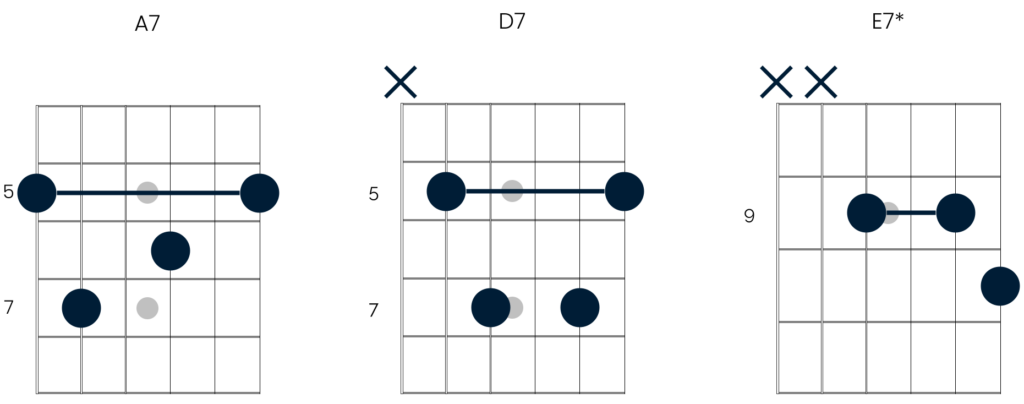
In this example, you use fairly standard voicings for the A7 and D7. The voicing for the E7 however, sounds quite different. In this way, the voicing helps you to accentuate the introduction of the V chord.
In turn, this emphasises the turnaround section of the 12 bar blues, which is the most interesting and tense section of the progression.
This is just one example. However by taking the chords illustrated above and moving them around the fretboard, you can begin to experiment with different chord voicings in your progressions.
This will allow you to break away from always playing the same chords and allow you instead to intentionally target different sounds in your rhythm playing.
Theory vs. reality
When you are going through this process, it is worth being aware of a number of different points. Two of these relate to the diagrams above and are as follows:
Firstly, you might have spotted that one of the chord diagrams is marked with an asterisk (*). I have highlighted this on the diagram, as this chord is actually an inversion.
As noted above, this simply means that the root of the chord is not the first note to be played. In that inversion of E7 for example, the first note that you play is the note of B. So instead of the chord running:
E G# B D
It instead runs:
B E G# D
As you might expect, this alters the quality of the chord and how it sounds. It also alters how you trace the chord up and down the fretboard. This is because you are not building the chord from the root note on the D string. Rather, the root is on the G string.
Although this might seem confusing, using inversions actually allows you to create many more chords, and also gives you access to usable chord shapes. Which brings me to my second point.
The keen eyed amongst you might have noticed that I alter one of the chord voicings when playing through them in the video above. Specifically, I make this alteration:
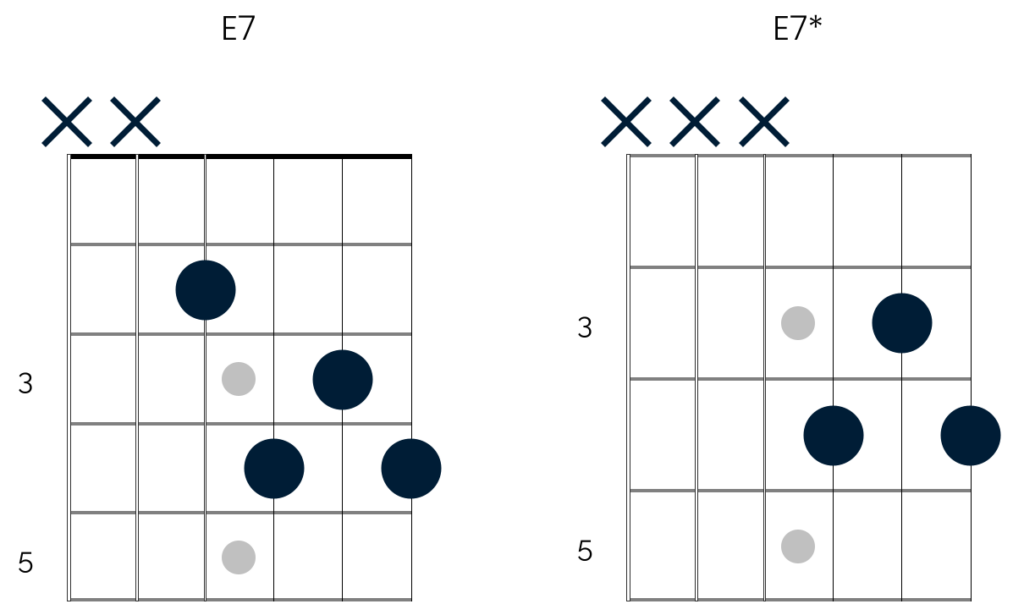
The chord illustrated in the diagram on the left is a regular E7. When I play the chord in the video at the 30 second mark however, I omit the root and play the chord illustrated in the diagram on the right.
Technically speaking, this is a ‘rootless’ chord. It contains all of the notes in an E7, but not the note of E.
If you play the two versions of the chords one after each other, you will hopefully see that:
1.) The chords sound almost identical
2.) It is much easier to play the chord without the root
To cover the theory beyond this kind of chord is an involved subject and one that goes beyond the scope of this article. It is also likely to be overkill if you are simply in the phase of expanding the chords you play in your 12 bar blues progressions.
I simply shared this to illustrate that there is a practical consideration with these chord voicings. The chord on the right hand side of the diagram is easier to form and play. This is significant, as it reduces the friction of including the chord in your repertoire and increases the likelihood that you will actually use it in your rhythm playing.
Lastly, it is important to recognise that the chord voicings which work in any given key are likely to vary. You might find for example that the chord voicings that have their root on the 6th string work well for those keys in the middle of the fretboard (A, B, C etc). However you might find that they sound too dark or bright in other keys.
As always, experiment and keep testing out new ideas, and you will soon discover what works well in each key.
Closing thoughts
Chords and chord theory can quickly become complicated. As such, if you are feeling overwhelmed by some of the various different points outlined here, just focus on the essentials, which are as follows:
- The term chord voicing refers to different ways you can play the same chord
- Targeting different chord voicings can help you to create different feels in your rhythm playing
- The chords illustrated above provide 5 different options that you can use in your 12 bar blues progressions
- All of these chord shapes are moveable and can be traced up and down the fretboard
So, if you have fallen into a rut and are always using the same chords in your rhythm playing, give some of these voicings a try. They will help to broaden your chord vocabulary, and make you a more well rounded rhythm player.
Good luck! If you have any questions, just send them across on your dashboard. Otherwise, I’ll see you next time for another quick tip 😁
